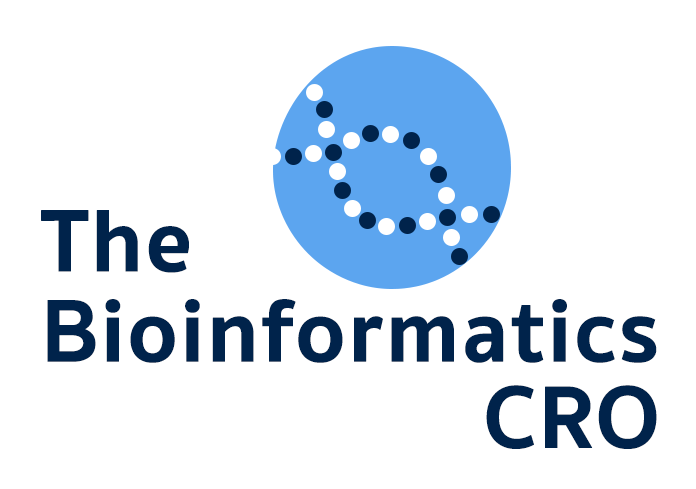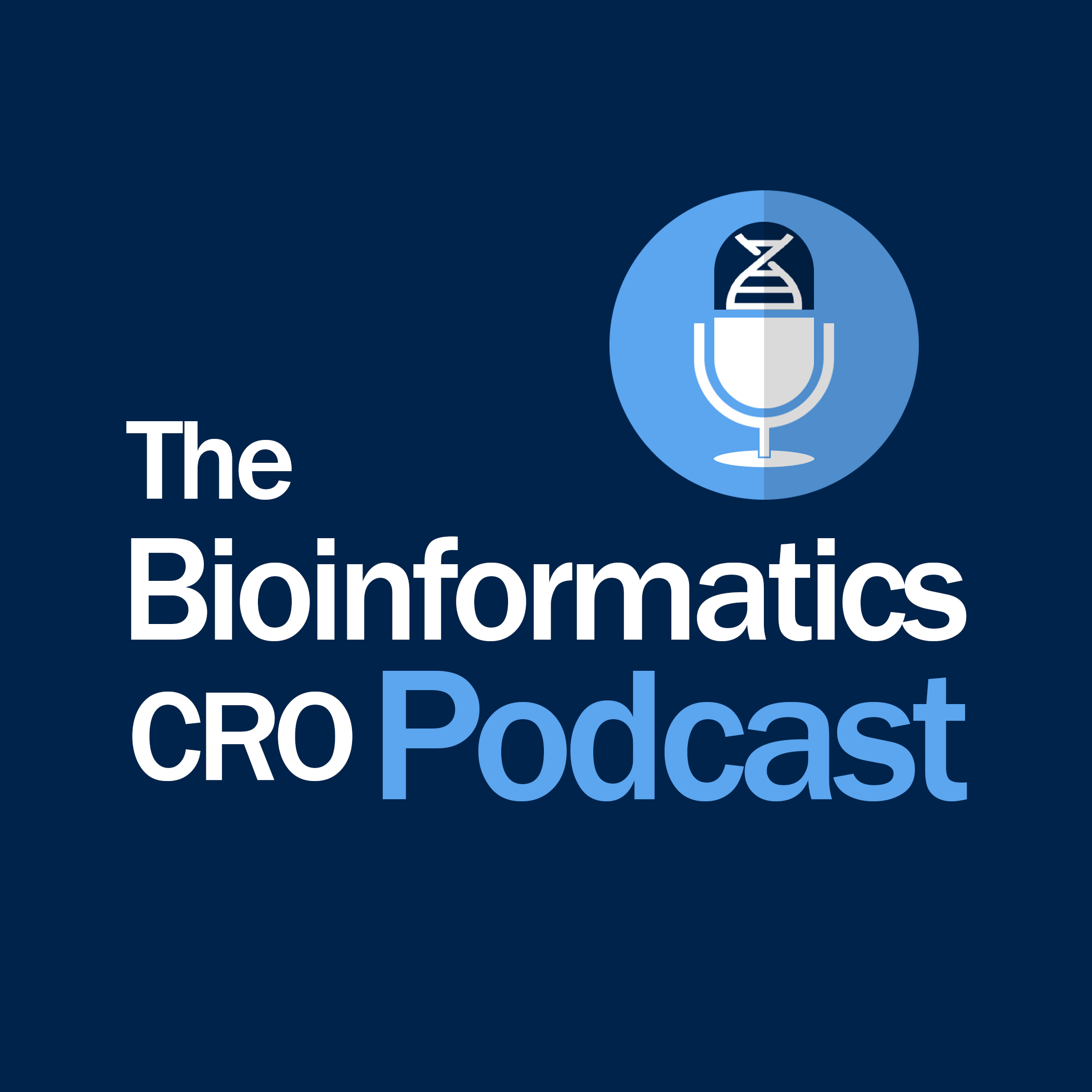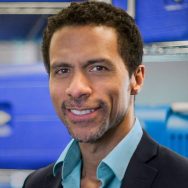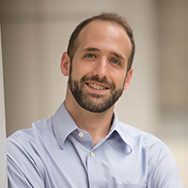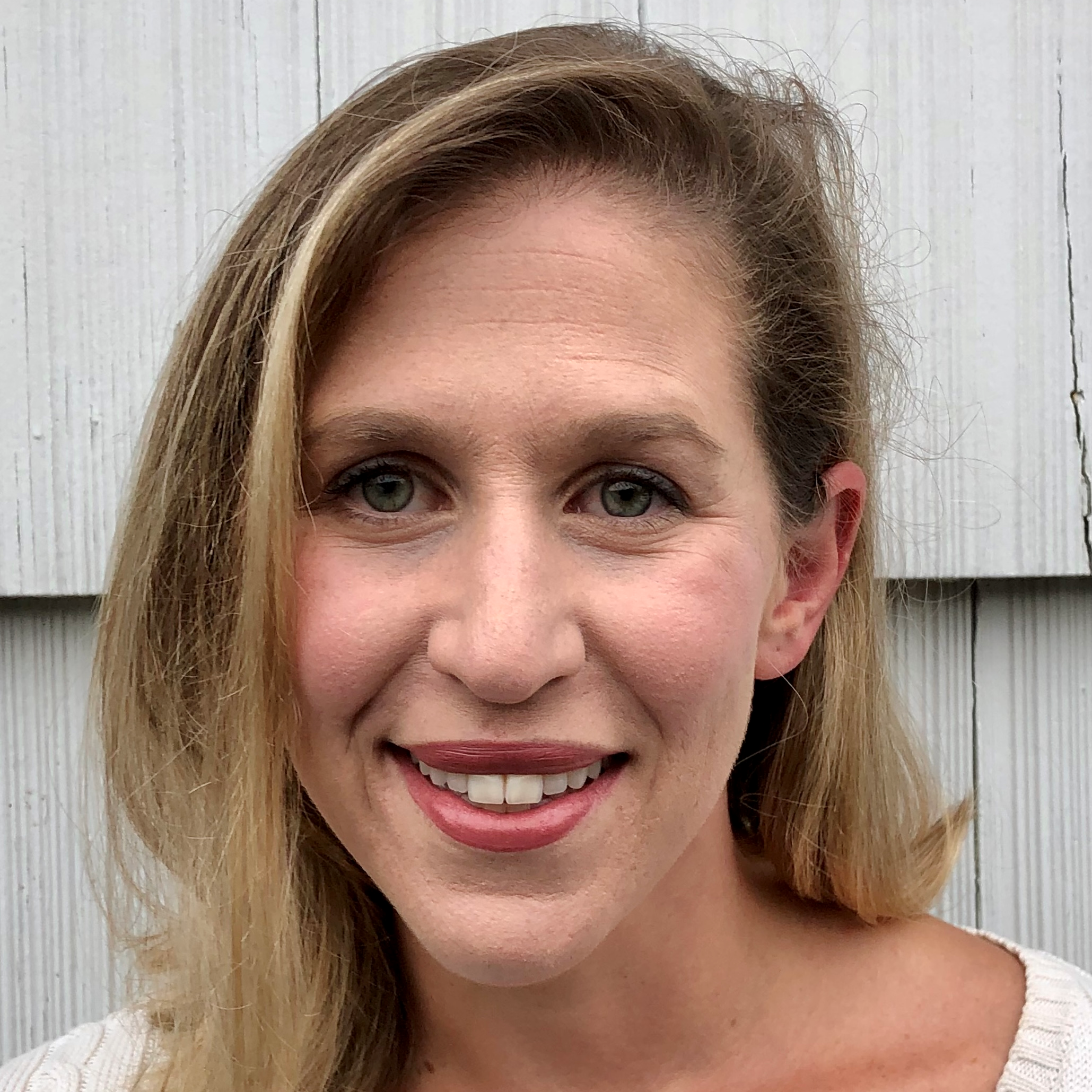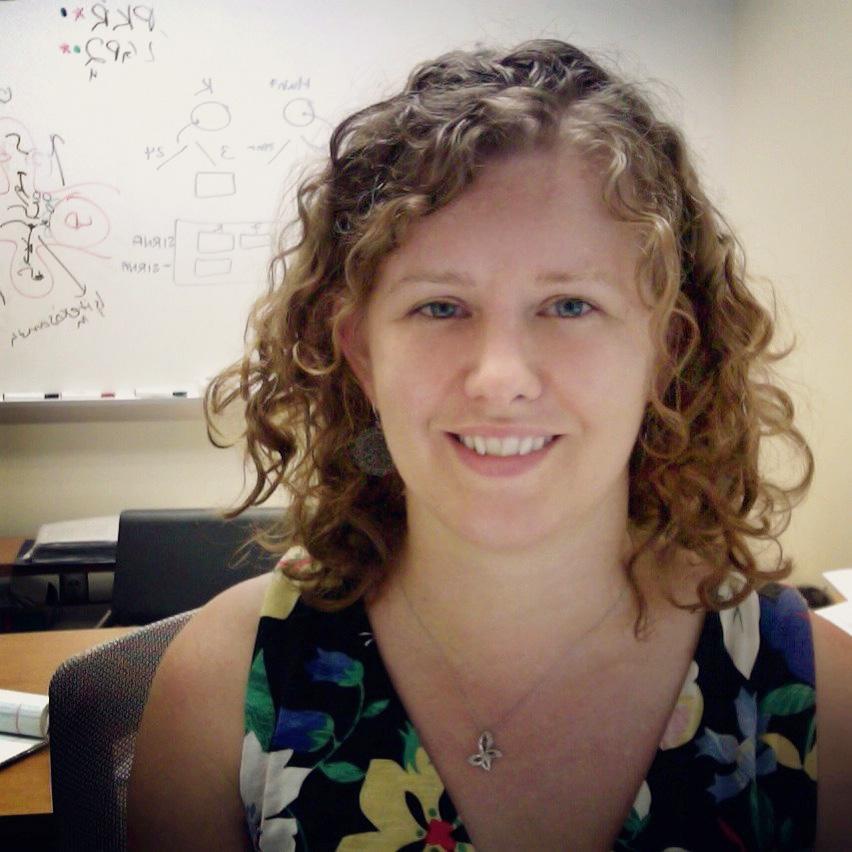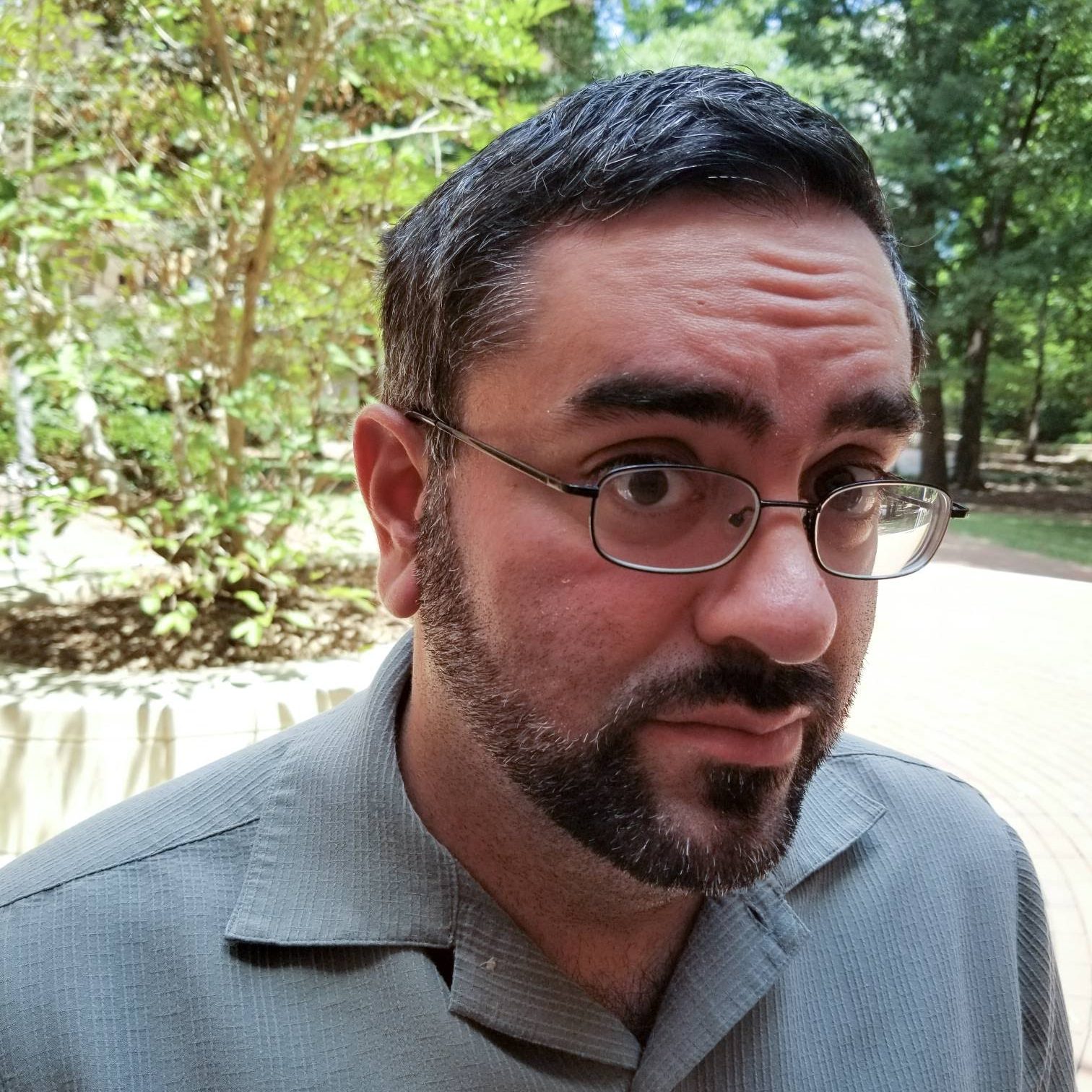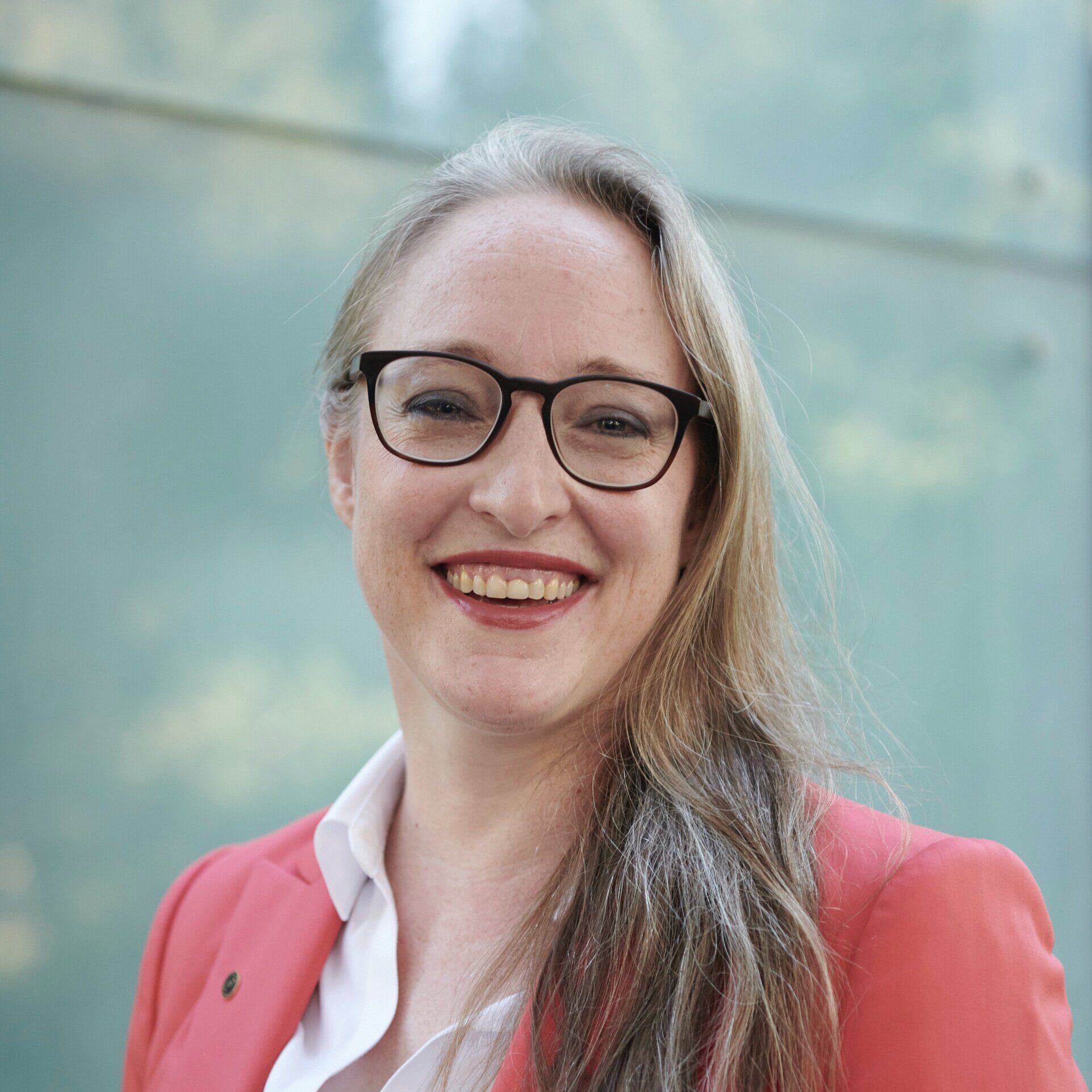The Bioinformatics CRO Podcast
Episode 43 with Erich Jarvis
Erich Jarvis, Professor at Rockefeller University and investigator at HHMI, explains how studying the neural and genetic mechanisms of vocal learning in songbirds gives insights into the development of spoken language in humans.
On The Bioinformatics CRO Podcast, we sit down with scientists to discuss interesting topics across biomedical research and to explore what made them who they are today.
You can listen on Spotify, Apple Podcasts, Amazon, and Pandora.
Erich is professor at The Rockefeller University and investigator at HHMI, where he studies the mechanisms of vocal learning in songbirds and other animals. He has earned numerous honors for this research, including the Alan T. Waterman Award and National Institutes of Health Director’s Pioneer Award.
Transcript of Episode 43: Erich Jarvis
Grant: [00:00:00] Welcome to The Bioinformatics CRO Podcast. I’m Grant Belgard, and joining me today is Erich Jarvis. Eric is Professor at Rockefeller University and investigator at HHMI. Thanks for joining us, Erich.
Erich: [00:00:11] You’re welcome.
Grant: [00:00:12] So can you tell us about what your lab does?
Erich: [00:00:15] My lab studies the brain basically, but we study more specifically brain regions that control our ability to imitate sounds like that I’m doing now, producing the learned speech. And we do so in non-human animals that have that ability, like parrots and songbirds. These are rare few species in the world that can do this that are shared with us, even though they’re not closely related to us. So this is why parrots can imitate us where a dog can’t. We also have a genome lab that is generating lots of high quality genome data, not only for our neuroscience projects, but for the scientific community broadly, ranging anything from neuroscience to conservation.
Grant: [00:00:53] How do you think the genome effort can inform the neuroscience effort?
Erich: [00:00:57] Most traits are controlled by what’s in the genetic code of your genome and the genes in your genome. And so if we find this specialized trait like spoken language in humans that we don’t find in our closest relatives or like in parrots, we can compare the genome of humans in chimpanzees or parrots and falcons and ask the question, what differs there in their genetic code? And the more species you have with these traits, the higher the N number, which helps you statistically find the specific genetic markers that will develop a brain pathway that allows you to develop a neural circuit for, let’s say, speech or learning how to fly.
Grant: [00:01:38] And how similar are these circuits between humans and birds with vocalization?
Erich: [00:01:43] What’s surprising is that some of the similarities outweigh the differences–when I say we, it’s me and other people in the scientific community that study this not just my lab–but overall, we find that humans and parrots and songbirds have a specialized forebrain circuit in the parts of the brain you would call the cortex and the basal ganglia that you don’t find in any species that cannot imitate sounds or find it to a very rudimentary degree. So the fact that they are there is similar, right. And then they have some connections that are similar. Like the cortical regions in us humans and the equivalent in birds project down to the neurons in the midbrain that control the voice.
[00:02:30] And this connection is direct from the cortex where you don’t find those direct connections in species that can’t imitate. What’s remarkable is that we’re separated from birds by 300 million years of evolution. We have so many species in between that don’t have these circuits. Further, what’s remarkable is that the mammalian brain, including us humans, the cortex is a set of layered neurons like six layers, one on top of another. Whereas in birds, the neurons are clustered in the cortex. But yet, from the layered structured or clustered structure, you get a similar type of neural network that controls speech.
Grant: [00:03:08] So is this a case of convergent evolution?
Erich: [00:03:11] Yes, convergent evolution. It happened more than once in evolution, and it happened in similar way.
Grant: [00:03:16] Do you have any idea how many times this has happened?
Erich: [00:03:20] Yes. So far we think at least five times in mammals, us humans, whales and dolphins that together are called cetaceans, bats, elephants and then another marine mammal, pinnipeds. Those are seals and walruses and so forth. So it’s five out of like thirty two major orders of mammals. So you don’t find it in horses, for example. And amongst birds, we have parrots, hummingbirds and songbirds. So far no reptiles, no fish, no amphibians are known to have this trait.
Grant: [00:03:52] And is the kind of neural solution to the vocalization problem, for example, in mammals always the same?
Erich: [00:04:00] Yeah, it’s similar. So the similarity is that in all the species we’ve looked at so far, which is basically the three bird groups in humans compared to their closest relatives. I would call this spoken language pathway or the vocal learning pathway, I think they’re nearly equivalent that it is embedded inside of a motor pathway that controls learning how to move, like learning how to move the hands, learning how to move other parts of the body. And this motor learning pathway we can find in all vertebrate species that move right. So what we think happened is that the brain pathway for spoken language evolved out of the brain pathways controlling learning how to move and evolved by a brain pathway duplication. And so that’s why we think it’s similar in birds and humans because the ancestral brain regions out of which the speech pathways evolved were already there.
Grant: [00:04:54] How generalizable do you think the circuitry patterns are? Do you think that everything is built on this motor substrate and there are many, many paths to get to vocal learning and this is just the most common based on what was pre-existing?
Erich: [00:05:10] I actually think there are limited paths in which you can get to vocal learning. It’s like the evolution of wings, especially amongst vertebrates. Each time they evolved in bats, birds and ancient flying dinosaurs, the pterosaurs, they evolved on the upper arms, not one on the back or one around the tail and one by the feet and so forth. And the reason why is that there’s an environmental constraint. And that environmental constraint is the center of gravity. So if you’re going to fly in the sky, you need your wings to be near the center of gravity to fly more energetically. I think the same thing is happening to the brain. There’s limited ways you can evolve a circuit that’s going to control, learned sound production, especially through our vocal organs like the larynx.
[00:05:57] And I like to think of the surrounding motor pathway as the arms of the wings, right. And the vocal learning circuit as the wing structures themselves. But does that theme happen multiple times? I think my prediction is yes, no one really knows. But my prediction is that the motor learning circuits for different traits can emerge out of sort of canonical motor learning circuit and then become specialized. The specializations for speech in us humans and songbirds are of two forms. One is this is an advanced sensorimotor integrative behavior. We need to take sound coming through our ears and integrate it with movement of the jaw muscles and the laryngeal muscles and other things that control the sound production.
[00:06:46] That kind of sensory motor integration of auditory input motor output, I think requires its own special formulas–or algorithms in computer science terms–to work with each other. In fact, after vocal learning evolved it looks like only vocal learning species are the ones that can learn how to dance, synchronizing your body movements to rhythmic beats of sounds. And the reason why I think that is the case is because you need to synchronize rapid auditory input with motor output. So you need something special to have the auditory information talk to the motor information. And once that happened, it contaminated the surrounding motor circuits that control not just the larynx, but the hands, the feet.
[00:07:28] And so to have auditory input synchronize our body to rhythmic sounds was a side effect of spoken language. The second specialization I think that happened is the larynx has the fastest firing muscles in the body to produce sound. You need to move those muscles really, really quick to vibrate the air and produce sound or modulate the sounds. And we find that the neurons in the speech circuit for humans and in the vocal learning circuits of these birds are over enriched with molecules that control rapid-fire neurons that control neuroprotection so you don’t kill the neurons just by speaking. That’s another specialization you don’t find in the surrounding motor circuits.
Grant: [00:08:15] You brought up some pretty interesting things there. So you mentioned dancing is maybe almost a side effect. But when I hear dancing in the context of evolution, I think sexual selection, right. Do we know which came first?
Erich: [00:08:27] Yeah, we don’t. But there are a lot of theories out there of what cause vocal learning to evolve, and that includes spoken language and sexual selection is one of them. I can say that I tend to believe that because all the vocal learning species use their learned sounds for mate attraction or in case of non-humans for territorial defense. What we can do it for territorial defense as well, very few of them use it for more abstract semantic communication like we’re doing now to communicate ideas, to communicate concepts. Instead, they sing to attract mates. The more varied the songs or the more you steal sounds from the environment incorporated in songs like in mockingbirds, then more likely you’ll attract the opposite sex.
[00:09:16] Now, you would think semantic abstract communication, referential communication should be the first thing we use it for. What most people don’t realize—and even a lot of scientists–is that referential communication like using a sound to mean a bear, using a sound to mean this object over here, that’s already happening before even spoken language evolved. Like vervet monkeys have an innate repertoire of sounds that through cultural experience, they will learn to use for different predators or food and so forth. But the first thing vocal learners do with their learned sounds is to attract a mate. So that’s why I think it came first.
Grant: [00:09:56] In what species that have vocal learning, do you see rudimentary elements of culture? You’d certainly expect groups of dolphins and so on to learn from one another.
Erich: [00:10:07] Yeah. I’m going to answer the question you’re asking, but I think you might be asking a different question, right. Because all vocal learners culturally transmit their repertoires, whether they’re using it for semantic information or what we call effective information, like to attract mates. So it’s cultural once you have vocal learning. And by being cultural, you get different dialects, like we get different language and so forth. They further geographically you are separated. Now I think the question you’re asking on top of that is what species will culturally transmit information about their vocal repertoire that’s more informative like this sound means predator and so forth. And there are very few species that do that besides humans. Dolphins are thought to be one, corvid songbirds, which are basically crows, and Blue Jays and so forth, thought to be another. And the parrots, like African grey parrots.
Grant: [00:11:05] I guess another really interesting question that this raises is obviously comparative neuroanatomy and comparative genomics are enormously powerful tools to study this. But of course, a complementary approach is classic genetics or human genetics, right. I mean, looking at broken genes, seeing what they do, studying diseases and verbal defects and so on. How complementary have those been and have they pointed in the same direction, since work on FOXP2 and so on?
Erich: [00:11:35] Those two questions basically describe the approach we take in my research broadly. So yes, we use comparative genomics like a natural experiment. The more genomes you sequence out there with species with different traits, the higher probability you will find whatever genetic difference is responsible for those traits. So we sequence genomes and we compare genomes to find out if there’s convergence in all these different species with and without vocal learning. And if we find convergence, then we take those genes that have these convergent genetic changes. And what we’re doing now is taking the genes of a species that learns how to imitate sounds and putting it into the genome of a species that don’t like a mouse. And see if we can induce a change in the brain circuit to get us further along the path to becoming a vocal learner.
[00:12:34] And if we do, that proves that this gene is responsible for contributing to the trait and we can study what it does, its function and so forth. And if it doesn’t, we falsified our hypothesis. Another way of doing it is within one species like humans is you compare different people, and you find a family out there that has a speech disorder, speech deficit. They can do everything else fine, but they have difficulty in learning speech. And then you sequence their genome and you find something that’s different from them compared to all the people who can produce speech normally. And this is exactly what happened, more than a decade ago in the discovery of the FOXP2 gene. This is a gene, it’s a transcription factor, meaning that it regulates how much a gene product is made for other genes in the brain, that controls neural connectivity.
[00:13:30] And when this gene is mutated, it causes people to have difficulty learning how to produce speech. And we put that same mutation in mouse in collaboration with Simon Fischer in Germany. We found that even though these mice are producing mostly innate sounds, like humans they had difficulties switching to the more complex innate sounds that females like to hear in their courtship, right. We find this gene in songbirds and if you block its function in songbirds, just like in humans, it also prevents vocal learning from happening normally.
Grant: [00:14:15] So how do you think about translatability?
Erich: [00:14:18] For a long time, I was hoping that the work we were doing in songbirds–because I started out with songbirds–people would take those discoveries that we found and then try to translate it not only into understanding human knowledge, but to for human health. And I found that people were not doing that. So the first thing we did was find out if we could find convergent parallel changes in human genomes that we see in songbirds for vocal learning. And the answer is yes. Not everything is convergent for the genes but there is a lot of overlap in the genetics. And now what we’re trying to do is to see if we can induce a mouse to become more of a vocal learner species and study things like stuttering or autistic types of speech deficits and these FOXP2 mutations in mice. So that one day those can be translated to helping humans not only understand the disorder better, but to repair it.
Grant: [00:15:24] And how do you think about that in the context of developmental windows, right? Because by the time someone is diagnosed with a speech disorder usually that ship has sailed. But do you think that can be reopened in some way?
Erich: [00:15:37] Because you can have multiple people out there with the similar speech disorder all affecting the same genes. You don’t have to wait for somebody to grow up, to become an adult, to discover it. So by doing a population analysis as opposed to longitudinal analysis, you can get at discoveries quicker. Although waiting 13-14 years for a person to go through puberty and then find out whether they can produce normal speech and so forth is also necessary. That leads to that other part of the question the critical period of years. In all vocal learning species, there is a critical period or what we now call sensitive period, where it is easier to learn how to acquire speech early in life and later in life. And then once you pass puberty, it’s harder, like it’s harder to pick up a new language.
[00:16:24] There are certain set of genes that are turned up or turned down in the brain during those critical periods that close off the ability to learn as much as you can when you’re a child. And there are people who are now trying to switch those genes back on. So that allows you to learn, in this case, spoken language as well as you did when you were a child or at least getting closer to that. And I think that’s going to one day be possible, but it’s going to cause some problems also. And the problem that people don’t appreciate is that. Why can’t I learn as well as when I was younger? Why is it taking me so long to learn how to ride a bike as an adult then when I was a child?
[00:17:04] And the reason is that if your brain is in a very plastic stage where you can mold it and learn a lot quickly, you’re also going to forget quickly. And this is why, sometimes it’s hard to hold on to early childhood memories because you forgot a lot of it because there’s only so much capacity in the brain. If you’re going to learn, sometimes you’re going to erase. And yes, you can erase memories. So if you’re going to reopen the critical period, you better do it for a brief period of time. Learn what you can so you don’t erase a lot.
Grant: [00:17:35] This sounds like a premise for a good novel.
Erich: [00:17:38] That’s right.
Grant: [00:17:39] So what excites you the most about this field? What do you think is most promising, and what do you think are some of the biggest as yet unanswered questions?
Erich: [00:17:51] Yeah. What excites me most? Well, maybe I went into neuroscience because I was interested in something that was mysterious. The brain is one of the organs that we have the least knowledge about, but the biggest investment in or one of the biggest investments. I guess the biggest investment is in cancer broadly, but cancer affects the whole body. And so I’m talking about organ systems. Maybe the heart gets bigger investment. But I’m just fascinated by the fact that we have this kind of behavior or spoken language that allows us to culturally transmit knowledge from one generation to the next. It makes us humans the advanced species that we are. That’s what really fascinates me.
[00:18:32] Jumping many years later from me, starting this lab over 20 years ago. The biggest problem now is I would say mental health. It’s one of those things that’s a real mystery and is hard for us humans to figure out how to repair. It’s not as simple as stitching a wound and fixing it. And I think mental health is a bigger problem in humans than in other species. Not a lot of people think about mental health in other species, but think about your dogs who are home lonely and so forth, right. That can cause mental health disorders. Now people will listen to this, and they won’t want their dogs to be home alone. Get another dog to play with it, right. I think the problem is goes to another gene that’s actually involved or interacts with genes involved in language and spoken language circuits.
[00:19:22] In us humans, we have extra duplication of a gene called SRGAP2, spelled out as SLIT-ROBO GTPase. SLIT is a molecule that binds the receptor called ROBO. When they interact, they influence connections in the brain. Those two genes, SLIT and ROBO are turned up or down in certain brain regions that control speech that we think control the connection to the muscles that control speech. I’m sorry, I’m giving you all these molecular terms that the general audience might know, but I’m going to do it anyway. This GTPase modifies this SLIT-ROBO interaction to influence connections in the brain. It either dampens down its function or enhances its function. And so we humans have an extra copy of this GTPase molecule.
[00:20:16] And what that extra copy does is it inhibits the function of the normal gene. And by inhibiting the function of the normal gene, we slow down brain development in humans compared to other species. So our brain is developing at a slower pace and staying in a more juvenile state throughout adulthood compared to all other mammalian species or vertebrate species. And I think it’s leaving our brains in a more immature state, which then leads to more mental health disorders compared to other species. So some of these mental health disorders, are a consequence of having a more advanced civilization and our brains staying in a more juvenile-state so we can continue to learn throughout life.
Grant: [00:21:04] That’s a fascinating hypothesis. So I guess in that case, you might expect that there could be SRGAP knockouts, assuming its survivable out there walking around. Do you know if anyone’s kind of looked into what those phenotypes look like? Are there people whose brains basically mature much, much faster?
Erich: [00:21:22] That’s an interesting question. Because I have never thought of that, but it’s actually a doable question. And it makes me think, in humans there are either one or two extra copies of this SRGAP2 with people walking around. And it’s making me think, why have two extra copies in some people? And I’m thinking, maybe because one extra copy is not enough, you knock it out and then we become primitive human beings. The additional extra copy is like a safeguard in case one of them goes awry. I don’t know. There’s lots of genome sequencing being done on many people out there nowadays, and this question can be answered, theoretically. It might be difficult because what a lot of people don’t know in the genome world is a lot of the sequencing that’s being done on humans out there is being generated with what we call short reads.
[00:22:15] These are nucleotide base-pair sequences that are like 100 to 150 nucleotides long, whereas the genome is three billion, right. Whenever you have repetitive sequences like the SRGAP2 duplications, with short reads, it’s hard to figure out which copy is which. So you need long reads, long reads are more expensive, like from PacBio, Pacific Biosciences and Oxford Nanopore. And in the genome world when we produce high quality data, we’re using long reads. So they’re really figuring out this question. To answer your question, we’re going to need to sequence the genomes of a lot of people with long reads and then look to see if somebody is missing these extra copies of SRGAP2.
Grant: [00:22:57] That’s interesting. Yeah. I just had a quick look on gnomAD as well. And there are six observed putative loss of function SNV’s when there thirty-eight expected. And there are exactly zero homozygotes out there in all the genome sequencing databases that Nomad aggregates. So even the heterozygote knockouts are pretty rare.
Erich: [00:23:18] Interesting. And to think that this gene is in extra copies in humans. So you would think if we lose it, we will be like all mammals and would be OK, but probably and not.
Grant: [00:23:31] Maybe it’s especially important. So all this kind of leads us almost into our next segment. We’re talking a lot about dancing and its relevance for vocalization, and you were on the verge of going down the path of being a professional dancer, right. Can you tell us more about that?
Erich: [00:23:51] Yeah, that’s right. Actually a lot of my family were into the performing arts, and that’s the direction I was headed in. And a lot of them sang. I was an okay singer, but not as good as the rest of them. So what could I do? I started dancing in dance clubs and so forth as a teenager, back when they allowed teenagers to go to dance clubs. And I started winning dance contests, and I thought, oh, so I can dance. And I auditioned for a high school of performing arts here in New York City and got in. And was on my way to becoming a professional ballet dancer and jazz dancer. But at the end of high school, you know, I was really trying to make that career decision that many teenagers are trying to make. What are you going to do when you graduate high school?
[00:24:32] And I liked science as well. And my mother always said, do something that has an important impact on society. And that stuck in my head and I was choosing dance or science. And I thought as a scientist, I could have a bigger impact on society than I could as a dancer. And I think as a dancer, if you become a well-known dancer, you can have popular influence like anybody in the performing arts like actors and so forth. But as a scientist, I can make a direct impact. So that’s why I chose science. I went to Hunter College here in New York City. I got into a laboratory they were doing bacterial molecular genetics, studying genes that are involved in synthesizing proteins.
[00:25:18] And I found out there that being trained as a dancer trained me to become a scientist. They both require a lot of discipline. They both require creativity. Lots of failure before success. They’re not nine to five jobs. And so, so many things. Basically, I consider being a scientist is also being an artist.
Grant: [00:25:40] It’s fascinating. I never really thought of that before. What do you think doesn’t translate as well beyond the obvious?
Erich: [00:25:47] Being an academic scientist is like running like a small business. You have a lab, you have a people in your lab, you have the staff scientists, and you have the students and so forth. If you’ve got to raise money, your publications or your product. The more you publish, the more likely you’ll get money. So let me backtrack a little bit on that, right. It’s not as ruthless as the business world maybe, but politics and science, they seem to be two different worlds to me, especially at this time. You know, especially in the past four years before the current era where politics seemed to be anti-science.
Grant: [00:26:22] It’s interesting, right. You had a postdoc, who went on to be a pretty prominent politician in Puerto Rico.
Erich: [00:26:28] Yeah, that’s right. Ricky Rossello, my former postdoc, the governor of Puerto Rico. And I guess he’s a scientist, but I guess his politics didn’t mix with science that well, because he stepped down. I very much appreciated his time in the lab. He and I got along very well. I mean, he was a very creative, forward-thinking person. But I do encourage my students and postdocs and others not just to go into academia, but to go into other walks of life and including in politics. And even though I said they don’t mix that well, I do think we need more scientists in politics to help the world.
Grant: [00:27:08] And outside of academia, which is obvious. What paths do you think the PhD route is especially good training for?
Erich: [00:27:16] I think the PhD route is training you for the kind of jobs that require lots of problem solving. You know, let’s say city planning in the business world as well. I think it helps with problem solving because in science, you’re always challenged with a mystery, an unknown that you’ve got to figure out and solve. So maybe being a detective, you know, maybe being a forensic scientist, something like this.
Grant: [00:27:44] And are you glad you did it? I mean, if you had it to do over again, would you be a scientist? Would you be a life scientist? Would you study vocal circuits?
Erich: [00:27:52] Well, I guess if I had to do over again. There are two questions that for me are like: would I come back to the same field? And outside of science, what would I have chosen? And within science, I was always fascinated with the origins of the universe. So I was trying to choose between the origins of the universe and of the brain. So I might choose that or how life began or something like that. Outside of science, I was fascinated with history. So maybe origins of human civilization, origins of culture. So I might have chosen that or maybe I would’ve just stuck with dance. Those are the ones that come to mind. You know, I also considered becoming an astronaut.
[00:28:32] Well, you can’t just say that. You have to competitively apply for that. To me, it’s kind of connected to science, but you know what I mean. I could have been flying planes or something like that. I have no idea. But that’s something I was considering.
Grant: [00:28:46] So it sounds like pretty much big questions like fundamental questions as opposed to kind of applied questions.
Erich: [00:28:54] That’s right. So fundamental questions and that’s what excites me. I’m as excited about being a scientist as I was being a dancer. Because I feel like I’m getting to fundamental principles, I’m doing something that is fun, even though, you know, it’s not fun to try to raise money and get rejected from grants or get your papers rejected and so forth. But hey, you know what, in the interim, I’m having fun.
Grant: [00:29:18] So walk us through your kind of key decisions in your career. You know, in college, you decided to go the life sciences route and then you stayed in New York for your PhD, right?
Erich: [00:29:29] That’s right.
Grant: [00:29:30] And what made you decide neuroscience over, you know, cosmology or something?
Erich: [00:29:35] Yeah. Well, let me give you a little bit more context because actually, I started out wanting to be a magician when I was a young child. And I was emulating Houdini as a teenager, going down different parts in the New York City with my cousin Sean to be tied up and escape from chains and ropes and so forth. And we would figure out how to trick people into believing that something magic happened when it really didn’t happen. And so that kind of actually got me into science. And plus my father was interested in science. Because I started getting tired of trying to trick people. I really wanted to know how things really work. And then, jumping years later into my transition into neuroscience, it was really connected to dance. I felt with dance, the brain controls dancing. It’s something I can hold in my hands. It’s here on Earth. I don’t have to look up to the sky to try to figure it out.
[00:30:30] And I don’t know, it was something I felt more biologically grounded. It was a simple holistic way of thinking, and that’s why I chose neuroscience. But during my undergraduate years at Hunter, I was still kind of undecided in that trajectory. You know, is it going to be something in the biological sciences like neuroscience or is it going to be or is it the universe? So I double majored in biology and in math because if I went into physics and astrophysics, I knew I needed a strong mathematical background so I would have the choice by the time I graduated, which one I was going to do. The mathematics gave me a decent bioinformatics foundation for biology.
[00:31:06] And nowadays, you know, biology is so heavy with big data that that mathematical background is helpful. And then I was going to add one more thing onto that, which is I was toying around with the idea of should I go into activism, into politics? My mother said, do something has an important impact on society. And I did think about politics and so forth. And even within the sciences, me as a person who’s an underrepresented minority of African-American descent and mixed up with lots of other things, I thought about becoming more active in trying to change the culture. And I got asked to do this a lot, but I find that it’s actually like having two jobs.
[00:31:50] And so I figure I want to make a change in society by being a role model, by being an example that as opposed to putting a lot of energy in trying to change policy, which means politics, right. So that’s something else I had to consider that I had to toy around with and make a decision. Including now I was asked to be a director of this or X, Y and Z, because now I’ve made a name for myself in science. Maybe I could or help change. You know, you can’t do it alone. But I’m really still, even at this time in my career I want to make those discoveries about how the world works, how the brain works.
Grant: [00:32:31] What are your thoughts on how people should think about changes that need to happen in the culture of science and so on, right? Are there things out there that you think are especially productive? Things you think are counterproductive? How do you think about it?
Erich: [00:32:45] Yeah. I think what’s counterproductive is for the scientific community as a whole and individual institutions or departments to expect that the folks who are–I don’t want to call them victims, but who are being negatively affected by discrimination and so forth–are the ones who should be given the keys to try to find the solution. You know, I think the solution to what I call society’s racial disease is everybody needs to be get involved, whether or not they are perpetrators or racism or benefit from racial discrimination and so forth, we all need to be part of the solution for it to work.
[00:33:40] The other is that the scientific community needs to do more scientific research on not just social research, right, where you’re looking at behavior only.
But what is it in our human behavior that leads to tribalism in the form of racism? Why does that happen? And is there something genetic about that? Or is there some type of nature versus nurture influence of your social upbringing that leads some people to become white supremacists and others to become activists against those white supremacists? I think there needs to be more hard science that goes into this to find solutions.
Grant: [00:34:07] What do you think are the most important questions to answer along those lines?
Erich: [00:34:12] I think some of the most important ones are where is the overlap or the interaction between tribalism, economics and health? Ok, so I’ll say it again tribalism, economics and health. Because I think those three together are the problems that are contributing to this racial disease where the economics and the health become a problem, right, then the tribalism breaks out. And so where is that tipping point? Then we can find ways to prevent that from happening.
Grant: [00:34:44] What are the ways that you kind of approach this problem that you think differ from maybe how others may?
Erich: [00:34:51] What I think I do that’s differing from many others–I won’t say many others, but enough others–is I think I learned how to have more resilience than I realized. It’s a level of resilience that I don’t think should be necessary, but it was necessary. And that resilience is not only resilience to folks who say or do things that would be purposely discriminatory. Some people really thought I had an unfair advantage with affirmative action programs, for example, or that I am less than or because of the color of my skin, my ethnicity, that I’m not as smart. I’ve met people who think that way in the sciences, right. So you’ve got to have resilience to that. And you’re going to need resilience to implicit bias where someone is saying or doing something, but they don’t realize what they’re saying or doing is discriminatory and they have all good intentions.
[00:35:50] And I say that because I have had enough people in my office, people of color who come to my office crying about something or feeling less than. And I’ll say resilience also to the impostor syndrome. Do I belong here? Do I belong at Rockefeller? I’ve had that question both as a student and interviewing as a faculty member. You’ve got to have resilience to your own imposter syndrome as well.
Grant: [00:36:15] And that’s interesting because at least most recently, right, when you returned to Rockefeller, you were already very, very well established at Duke, right. And even at that time, was that still kind of a something you were dealing with?
Erich: [00:36:27] Yes, it was something that I was dealing with. And it even surprised me when I realized that. And it was a few other famous scientists basically saying that, Erich, you’re lowering yourself too much. And I was surprised because I would rather underestimate what I am, than overestimate. But, some people were saying that I was doing too much of an underestimation and I realized it was because of my minority status that I was doing that to myself.
Grant: [00:36:57] And so how would you encourage earlier career scientists of color?
Erich: [00:37:02] Yeah. I found a way to evaluate myself because like I said, you don’t want to overestimate either. If you get too confident, you might do something stupid in the field and send a grant proposal in that’s really horrible. And then get a reputation that you’re sending in horrible grant proposals for your work. I try to balance my evaluation with my own self-evaluation and what others think. In the beginning phase it’s going to be hard because you’re just starting. So I would say to the younger scientists, and that includes the students, you know, go get some opinions of different faculty members. Don’t depend on one because especially as a person of color, you might find one or two that are going to undervalue you anyway.
Erich: [00:37:46] And if they start saying to you that it’s okay that you’re not going to achieve as much as somebody who’s white, be careful because they might undervalue you. That’s why I say get multiple opinions. Don’t accept everything they say, but listen, understand everything they’re saying and try to improve what you’re doing based upon that knowledge. Later in life as you start to publish papers and so forth, the way I do a self-evaluation is at the end of every year, I see what the citation rate of my papers are, what impact my papers are having on the scientific field. And now I have out of the hundred and sixty or so papers we’ve published over my career even since I was an undergraduate student.
[00:38:33] Something like 20-25 of them, maybe more than that are cited in the top one percent of papers in their field, according to the metrics. So that can’t be because of the color of my skin, you know. So I use that as a metric to answer that question.
Grant: [00:38:53] That’s fascinating. Yeah, we actually, on our blog have compiled, to my knowledge, the only database of H-index distributions at different institutions for biological scientists who involve computational biology in their work. And so you can go and say I’m an assistant professor, associate full professor at this kind of institution, like what the H Index distribution looks like.
Erich: [00:39:21] Wow, that’s good to know. I’ll check it out.
Grant: [00:39:24] Cool. So what do you think has changed about how science is done today from when you were, just entering the field?
Erich: [00:39:34] I was born in 1965, right. And so I entered science when I was eighteen years old, right. So we’re talking early 80s. So when I started out in the early 80s, science was a lone ranger approach. Especially when I got to graduate school, I was taught, you have to figure out everything yourself. And you have to be first or last author on the paper. You know, I mean, this kind of thing is still the same now, but it’s less so than it was before. And I found that that was a Western European model of thinking because I grew up in an African American family, with some Native American culture mixed in there. And of course we were surrounded by European culture around this right. I was thinking of like a Martin Luther King approach, you know, bring everybody together be very collaborative.
[00:40:21] And the advice that I was getting is, I’m doing too much collaboration. That I’m not distinguishing myself enough and so forth. Even from when I was getting tenure and so forth and some other people pulled me aside and whispered, don’t pay attention, you’re doing just fine. So I took this more collaborative approach to science, and now I’m finding that I’m good at it and I’m leading large international consortia for genomics or neuroscience and so forth. And I’m getting credit for it. We produce more papers and we switch around authors on different papers and so forth. And they’re coming out as some of the most highly cited papers in the field.
[00:40:58] And also for me, what really counts is not so much your credit, but the discoveries that are made. And so that was my Malcolm X training, right, which is by any means necessary. So if you need to collaborate, do it. If you need to take the lone ranger Western European approach, do it. What is the necessary approach to make the scientific discoveries? And what I’m finding is that as science diversifies more and as big data in the biological science grows, collaboration is necessary. This lone ranger approach is becoming less and less viable and prevalent.
Grant: [00:41:37] And there seem to be a lot of people who are unhappy with that. You see a lot of complaints about money that goes to the consortia, even though their data are indispensable, right. At the CRO, we rely on GTex, we rely on TCGA, we rely on ENCODE and so on, right. We rely on these big consortia data all the time, every single day.
Erich: [00:42:00] Yeah. I’ve heard people who aren’t into big consortia projects. They just want to have six people in their lab and that’s it. They complain about our consortium projects, about how competitive they are.
Grant: [00:42:14] What do you think is done poorly right now in science? What do you think most needs to be improved?
Erich: [00:42:24] I think two things right. One of the biggest things we poorly do in science is communicate to the public about what we’re doing. I think the public is undereducated in the sciences and sometimes miseducated and purposely so for political reasons. This is something that is changing. When I jump back to the 80s and 90s, we were taught don’t talk to the media that much. Don’t do a podcast, right. Because you’re selling yourself or you could say something wrong. Or somebody could misinterpret it because they’re not a scientist. And therefore, you get a bad reputation in the scientific community. Or you are trying to make a big name for yourself, like Carl Sagan.
[00:43:08] But I think that attitude does us a disservice. I think when it comes to the public good and the scientific community throw the humility out the door, educate the world as to what we’re doing and learn from them as well. So that’s one. And the other is, I think we don’t have a big enough financial investment in the sciences. There is a lot of money going into, you know, I guess the one that get criticize all the time is the military, right. But I think the business world and political world could invest more money into science education, even if those students don’t become scientists. I think it’s going to be better for whatever they go into and for the scientists themselves. Of course, that’s self-serving since I’m a scientist. But I think we can we can do a lot more for the climate turning around what’s going on, climate change for our own health and so forth. And just for basic understanding of the world if we invest it more.
Grant: [00:44:05] Totally agree. And to your first point, the reason I went into the life sciences in the end was actually reading some pop science books that Richard Dawkins had written. And then when I went to grad school and was classmates with the number of people in his department and so on. I learned that within the department, people would complain about him a lot and really it sounded more or less like they were jealous that this guy who gets all this attention. But you know, they’re publishing better and all this stuff. And my thought all along was well, but yeah, OK, maybe his publications aren’t as impactful internally. But big picture, he’s probably having a lot more impact because he’s drawing a lot of people into the field who otherwise may not have gone.
Erich: [00:44:46] Right, exactly. So we need we need people like him.
Grant: [00:44:51] Cool. Do you have any final words for our audience, words of encouragement?
Erich: [00:44:57] You know, pigging backing off this last topic. I feel that what scientists need to learn how to do, including myself, is to translate. Not only to translate from bench to bedside type of translation of discoveries, but translate knowledge from the scientific establishment to the general public. And we don’t have enough good translators. And so it’s good to have you as a translator. But we scientists, we need to learn how to make that vocabulary and grammar and so forth understandable.
Grant: [00:45:34] Totally agree. Well, thank you so much for joining us. It was a lot of fun.
Erich: [00:45:39] You’re welcome.
